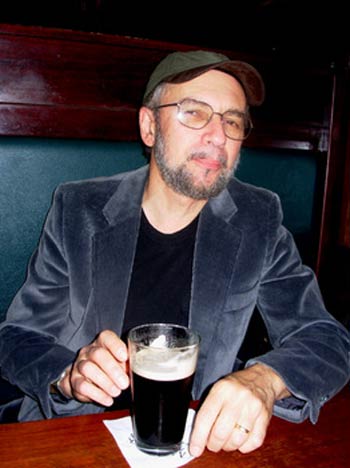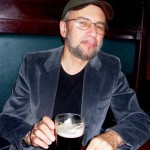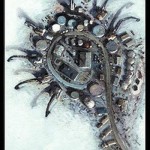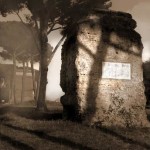By CHARLES GIULIANO
For many years yard sales and flea markets have been a way of life for my artist friend Harry Bartnick. Over a beer and burger recently, actually he doesn't eat red meat but likes a single pint of Guinness Stout, he explained that during his annual solo trips to Europe (his wife Mary often joins for at least a part of the time ) he stated that for everything on a "good trip": Flight, hotels, museum admissions, meals and miscellaneous, he can get by on $85 a day. Of course it depends as Italy is more expensive than Spain. For the price of a hostel in Italy he and Mary had decent hotels in Spain. "Except for Pamplona," an apparent nightmare. Hey, it happens.
But he was about to have a yard sale. To clean out the garage/ studio which is, you guessed it, full of stuff he bought at yard sales. Through a combination of factors the studio has been neglected for the past six years. Or, relocated as he has been working with computers and printers to scan images taken over many years of travel. He is best known for his representational paintings which when he put down the brush for a hiatus involved aerial views of landscapes often showing the impact of environmental issues. The works were labor intensive and larger paintings took up to a year to create. It's not that he lost interest, and hopes this summer to literally take up where he left off with several unfinished works, but the process of saving and scanning images became ever more absorbing and seductive. He described it in his own terms as similar to what happened when photography was introduced in 1838 and begged the entire question for artists of why try to labor to reproduce nature when the camera can do it with even greater accuracy. Why compete?
Over the years his paintings have earned peer support and grant recognition. He won a John Simon Guggenheim Fellowship in Painting in 2001. While he banked the money and used it toward travel and hiring planes to take him over the Roman landscape for aerial views, significantly, he used some of the money to upgrade his scanner and printer. He also won a Massachusetts Artists Fellowship Grant in 1981 and Grants for Painting from the New England Foundation of the Arts in 1992 and 1996. More than 25 years ago we met as colleagues at the New England School of Art & Design and he is a tenured professor now that it has merged with Suffolk University.
I asked if teaching art had ruined him as an artist? But, as usual, he wouldn't fall for my ploy and responded that actually having the security of a well paying job had freed him from the need to "fill orders" for painting in what he regards as a fickle and rudderless art world. It is one his favorite topics, not that I disagree but I am more embedded in it, and he argued passionately that there is "no paradigm." He wanted to know just who decides what is important in the art world. Not that I have any answers just different opinions. For one thing, to some extent, I try to stay on top of what is being shown in New York and internationally. To check out the galleries on a regular basis.
From time to time Harry has joined me for those New York trips and it was always fabulous to interact with him about shows that we took in. Although my pace tends to be warp speed while he can just linger and look for the longest time. Like that Norman Rockwell show at the Guggenheim some time back. I was in and out in like ten minutes and had to hang around for an hour or more while he attentively went from painting to painting. The reasons why I was bored and apathetic are all too obvious where Harry admired the kitsch master and illustrator as a painter. But for weeks, months, years after a joint visit to a Lucio Fontana exhibition the Italian slash artist became a running one liner, at least for him, about everything that is wrong with the art world. Actually, I rather like Fontana for a lot of reasons that I fail to convey to Harry. While I embrace the avant-garde, most of the time, he would rather wax poetic on the theme of Roman ruins.
There was an interesting drift as he went on about the Sagrida Familia in Barcelona and how the Bauhaus and the Germans, had put the kaibash on Gaudi and the decorative traditions of romanticism. Form follows function pretty much was the knife in the heart of the visionary Gaudi and art nouvean. Or, as Tom Wolfe put it, less is a bore. In the past couple of years, in addition to the obligatory time in Italy, he has explored Germany and very much enjoyed visiting the cities in a radius of Frankfurt and also visited Hamburg and Berlin. It is good to know that he is adding a bit of the Dionysian to the Apollonian. A bit of reverse English on Thomas Mann's "Death in Venice."
For such an Italianate romantic it is surprising that he grew up in Newark. During one of those shows we visited in New York an artist showed panoramas of Newark and Harry pointed out the old neighborhood. "It was the home of Stephen Crane, Philip Roth, Amiri Baraka, and Jerry Lewis," he said. "Newark was a tough but interesting town. The best thing is that it is a half hour from Manhattan. When I was a kid, about 14, I started exploring New York block by block. I got as far as mid town. I visited the museums and neighborhoods. In Newark I spent time in the library and there was the Newark Museum."
Exposure to Europe began with a junior year in Italy as a student at Tyler School of Art in Philadelphia. That was 1970-71 and since then he has been hooked. Even though he returns again and again to familiar places he finds them constantly changing as there are always new discoveries. Even before he traveled to Italy he had a passion for Roman history. "I was immersed in Greco/ Roman culture," he said. "When I am in Italy I am on Cloud Nine. If I am standing on a hill looking at another one in the distance I can just float from one to another. I don't weigh anything. Every time I go I discover new things. I try to spend a month each year so that's why I have to look for the cheapest fares and inexpensive places to stay. In Rome I always stay at the Yellow Hostel. I enjoy the camaraderie of hostels and being with young people who are making a commitment to travel and see things. Anywhere in Europe you connect on a different level. These cultures are far richer than what you get around here. They are more socialized and there is more elegance and beauty."
In the past while traveling he photographed, initially sparingly, because of the expense. The photographs were always a resource for the work. Gradually he became more involved in the medium as its own art form. "In the 19th century photography threw painters for a loop," he said. "Photography was competition as it could document nature a lot better in many ways. It pushed painting into new areas (where initially photography could not follow) like abstraction, expressionism and form." But while he has embraced the medium he strives to avoid the obvious. He commented on the millions of web sites with tourist shots of familiar views. "I want the work to have an edge," he said. "When I am in the studio I ask what to do with this image. Often the least likely shot proves to be the most promising with the most possibilities."
While he has been taking photographs since he was a teenager the transition really began about eight to ten years ago when he experimented with Seattle Film. The company sold old movie film and would process it providing prints, slides and a CD disc. Seattle Film also had its own program to play with the images using a computer. Eventually he made the leap to Photoshop and bought a slide scanner. Eventually he reached the limits of 35 mm photography which could only be enlarged to 13 x 19" prints. So he went to a medium format with a Mamiya Pro TL camera shooting 6 x 4.5 cm film which is twice the size of 35 mm. He also upgraded to a 24" Epson 7600 printer. Given that he tries to be as compact as possible when packing for Europe, the medium format camera and film are about as large as he can back pack. The next step is to a high end digital camera and laptop but right now that is too daunting.
"Scanning film is a pain in the butt," he said. "When I come home it takes a month to scan all the film after it is processed. And there are fewer and fewer places to process film." Like a lot of analog photographers the technology or its obsolescence may just force him to go completely digital. It is nice to just load the images onto the hard drive. He liked my nifty little Nikon Coolpix. But concluded that, while impressive, he needed more resolution for the large prints he has been making.
"You have to carry around film," he said. "And you never know what you get until it is processed. With digital you see it in an instant and can delete if you don't get the right shot."
But for all the involvement and investment in photography, he said "I still want to paint. I love painting. The juciness of paint. But the ability to correct images taken directly from life, to scan and edit, couldn't be passed up. My real interest has always been the image. Paintings images is great but photographing images is just as great. My experience as a painter also informs a lot of what I do in photography."
And what to do with this body of material? How about approaching galleries? He has scoped out a gallery in Rome which he plans to approach. There has to be the right context for showing the work in a setting where it is understood and appreciated. He states that "I am making images for a select group. It is not intended to be universally appealing to everybody."
This got us onto the topic of the art world. "Fame in the art world is like no fame at all," he said. "Celebrated to whom? My dentist doesn't know who these people are. They don't have Art Forum in the waiting room. If you want people to see your work you have to find other outlets."
The waitress stopped by to ask if we wanted another round. Harry politely asked if she knew who Matthew Barney, Jeff Koons and Damien Hirst were? There was an embarrassed silence. We left a good tip. So then, how to measure success as an artist?
"I'm happy with my work. But there are no prevailing values in the art world today. You can't gear the work to the viewer. There is no paradigm. It is just important to give it your best shot." Indeed.
- Harry Bartnick turns a skeptical eye on the art world.
- Paintings from the Arctic Trespass series present a bird’s eye view of the environment.
- Via Latina is one of his digitized photographs of Rome.
Bartnick portrait courtesy of the author.
All other images are courtesy of the artist.







